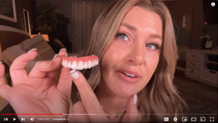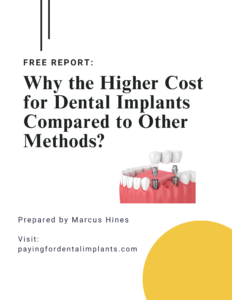Physical Address
12245 Cypress Spring Road, Clarksburg, MD 20871
Physical Address
12245 Cypress Spring Road, Clarksburg, MD 20871

Last updated on May 16th, 2025 at 07:56 am
Kristi’s journey from dentures to dental implants is fascinating. Several abscessed teeth led her to dentures by the age of 26 and eventually to dental implants. Her story has been gracefully documented on her Kalinjax YouTube channel. In this article, we chronicle Kristi’s experience of having bad tooth decay as a child, eventually having all of her teeth removed, receiving dentures, and ultimately how she was able to afford a complete set of upper and lower dental implant supported teeth. Kristi’s experience with making her dental implants possible may be our most fascinating story yet.
Kristi is a married mother of four. The sugary sodas she drank virtually every day as a child, led to a mouth full of decayed teeth.
“When I was a child, my parents couldn’t afford dental care for me, so I just never went [to the dentist],” Kristi shared on her YouTube channel.
Being deprived of dental care as a child is not uncommon. In fact, it is quite common. Approximately 50% of children in America receive inadequate dental care, in part due to economic reasons.
Eventually, Kristi’s grandparents took her to the dentist, but the cavities were so bad that two of her molar teeth required being extracted.
As Kristi grew older, her oral health continued a downward spiral. Mired with cavities, pain and embarrassment, something had to be done.
“By the time I was out on my own and responsible for myself, I was already in debt to my mouth,” Kristi explained. “I couldn’t get the [dental] work fast enough. I couldn’t come up with the money fast enough.”
-Kristi
With each pregnancy, Kristi’s decayed teeth worsened. Her teeth were extremely sensitive to heat and cold and it was painful to simply eat.
The physical pain was tough, but the mental anguish from picking herself apart in the mirror each day, hiding her smile and the embracement of being out in public made her feel miserable.
So at the young age of 26, Kristi decided to have her remaining teeth removed and replaced with a full set of upper and lower dentures. She paid $2,500 for her set of dentures.
Instantly, Kristi felt great about her new smile! However, dentures were never a part of Kristi’s long-term goal, for good reasons. She knew all along that she wanted to avoid suffering with massive jawbone loss.
She understood through her research, that long-term use of dentures would lead to significant loss of bone in her jaw.
The skeletal system requires physical stimulation in order to maintain its shape and form. Throughout the body, bone naturally receives this stimulation from walking, running, exercising, weightlifting and so forth. Without physical stimulation, we lose bone density.
How does the jawbone receive its stimulation? The lower one-third of our face – the jawbone – receives its stimulation from the roots of our natural teeth. Stimulation to the jawbone occurs when teeth are present and when we chew on food.
Once the teeth are removed, the jawbone’s ability to be stimulated is eliminated. The jawbone then begins to shrink or atrophy.
And it is this atrophy that can make someone in their thirties appear to look as though they are in their fifties or sixties.
Kristi was never content with being relegated to removable dentures for the rest of her life.
She knew that similar to natural teeth, dental implants help can help to prevent jawbone atrophy.

Natural facial structure with teeth compared to facial structure after bone loss without teeth.
After wearing her dentures for some time, Kristi noticed that they were not fitting quite as tightly as they did when she first received them. All the more reason her sights remained set on receiving dental implants.
There was one problem standing in her way; the cost. A set of fixed, full mouth dental implants for her upper and lower jaws, would cost somewhere in the ballpark of $50,000. And most dental or medical insurances will not cover this cost.
As much as Kristi had her sights on dental implants, at this point she was now a mother of four and didn’t know how she could come up with the money to pay for her much-desired implant procedure.
Since Kristi could not afford to pay for dental implant treatment, she got creative in her approach. This included a Google search of “smile makeovers” and the like. She looked for potential opportunities and contests that would position her to compete for free dental implant treatment.
She discovered an All-on-4™ contest that Dr. Mike Golpa out of Las Vegas, Nevada offered. Winning this contest would give Kristi an opportunity to fly to Las Vegas and receive a full set of upper and lower teeth, all supported by dental implants, for free.
At this point Kristi is 29 years old and had established a following on YouTube by sharing her experience with dentures. Wisely, she went on YouTube and encouraged her followers to help her win the implant contest by voting for her. Kristi won the contest!
This meant she would receive $54,000 worth of dental implant treatment, free of charge. Here is a breakdown of Kristi’s would-be treatment expenses:
| Resources Used to Cover Kristi’s Implant Expense | Funding Amount |
| All-on-4 implant procedure – upper jaw | $27,000 |
| All-on-4 implant procedure – lower jaw | $27,000 |
| All-on-4 contest winner | FREE |
| Total | $0.00 |
Visit Making Dental Implant Treatment Affordable for several ideas on how you can make paying for dental implants feasible.
Kristi’s full mouth dental implant process (All-on-4) took place over two days. To summarize this process, here’s how it would’ve likely broke down:
Day-one – Surgical procedure
Day-two – Delivery of bridgework
Provisional screw-retained bridges are designed to be worn, usually, for approximately eight to 12-weeks while the dental implants go through a healing process, technically known as osseointegration.
Once the implants are completely healed, the patient can return to the office for the final implant supported bridgework. This also gives the patient an opportunity to express any minor adjustments that they would like capture in their final bridgework.
This is how Kristi’s case was managed as well. Her dental implants were given a couple of months to completely heal before she returned to Vegas for her final implant bridgework.
Now that Kristi has received her final implant bridges, she is quite pleased with the end result. “Oh my gosh! I’m so happy, I’m so happy with these [bridges],” Kristi exclaimed on her YouTube channel. “Wow! They are amazing!”
In hopes of helping others who may be struggling with failing teeth or dentures, Kristi openly shares her story of having her teeth extracted and replaced with a set of dentures by the age of 26, followed by receiving dental implants at the age of 29.
Kristi’s willingness to chronicle this entire process, primarily through YouTube, is intriguing. Establishing a YouTube following also helped Kristi to solidify the votes necessary to win the All-on-4 implant contest.
Her treatment may have been free, dollars wise, but make no mistake about it, Kristi worked very hard in order for this to be possible. Her goal all along was to have dental implants.
Allow Kristi’s story to encourage you. No matter your financial circumstance, with strong determination, resourcefulness, sacrifice and hard work, there is a way to make your dental implant treatment affordable, or in Kristi’s case, maybe even free. Chances are you don’t have to settle for less.

This will close in 0 seconds
This will close in 0 seconds